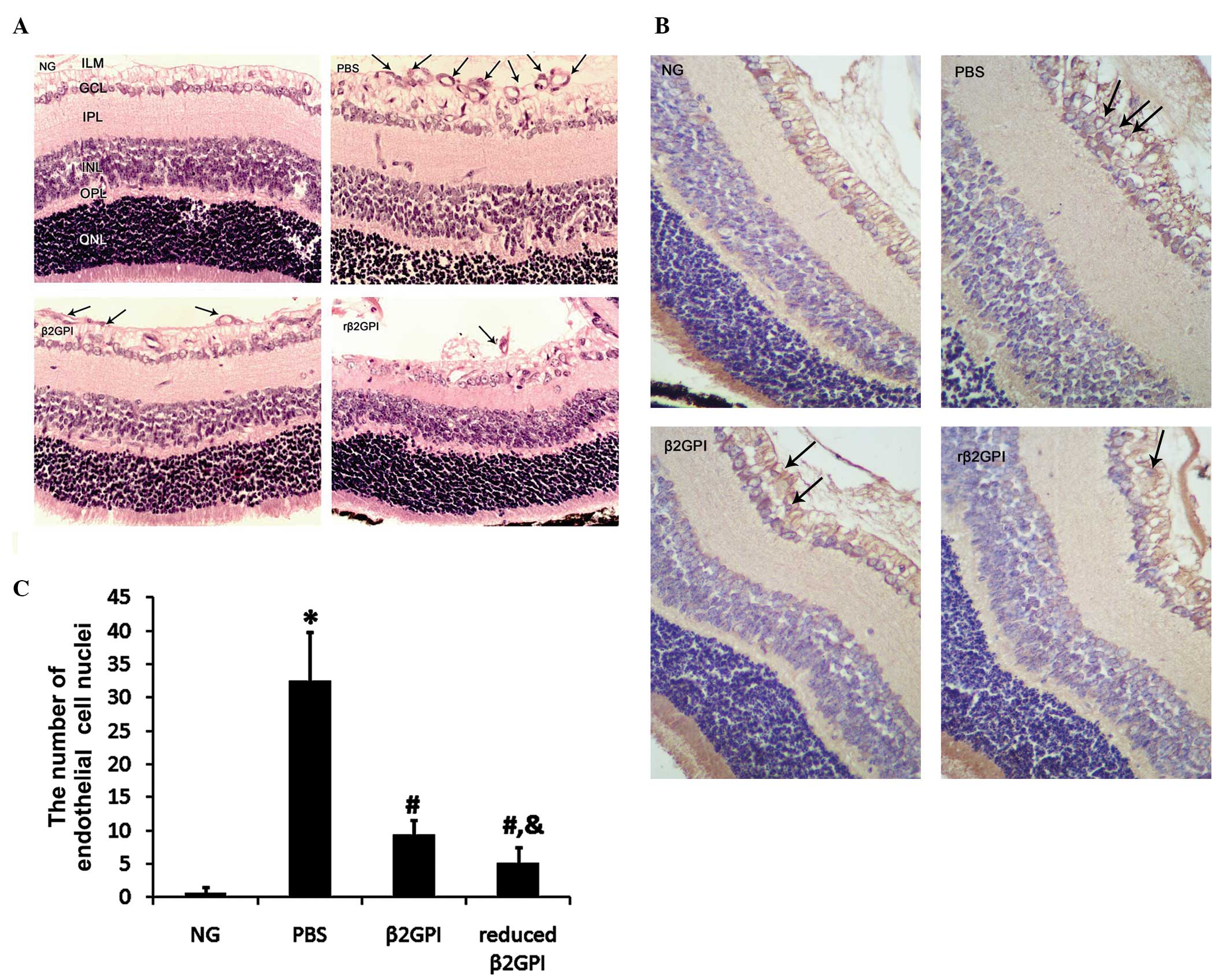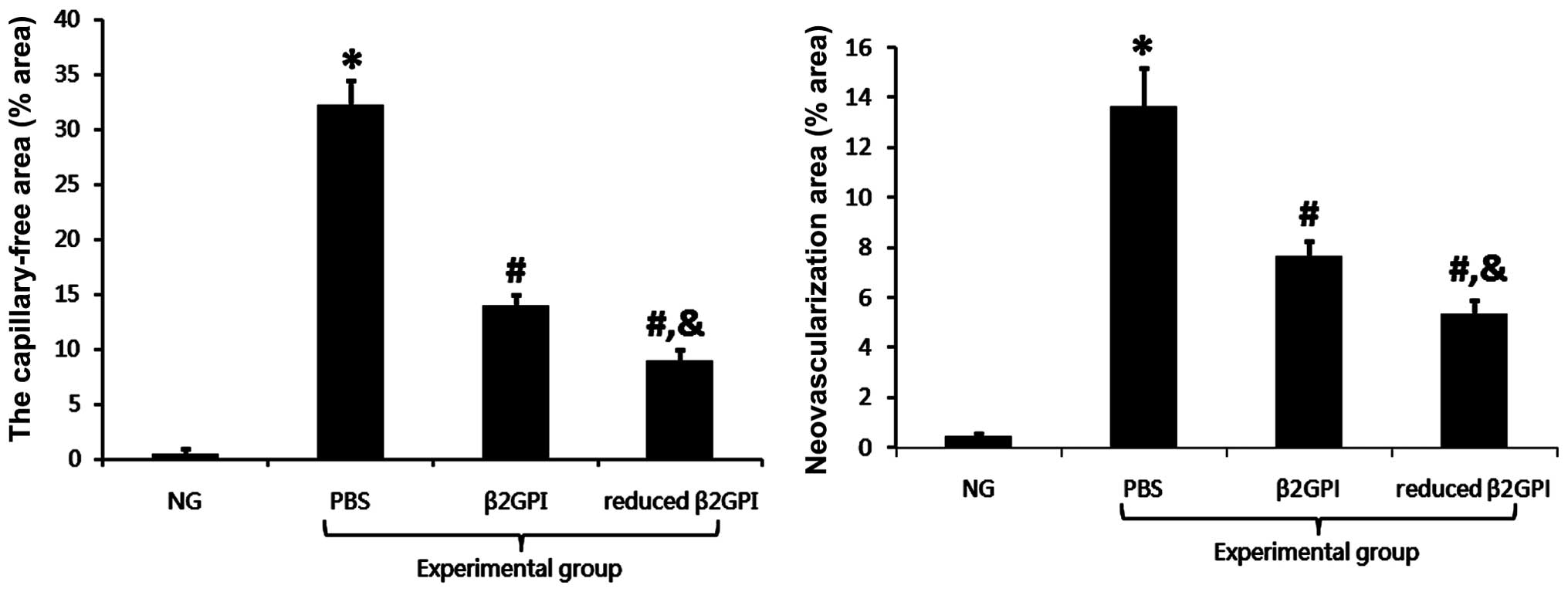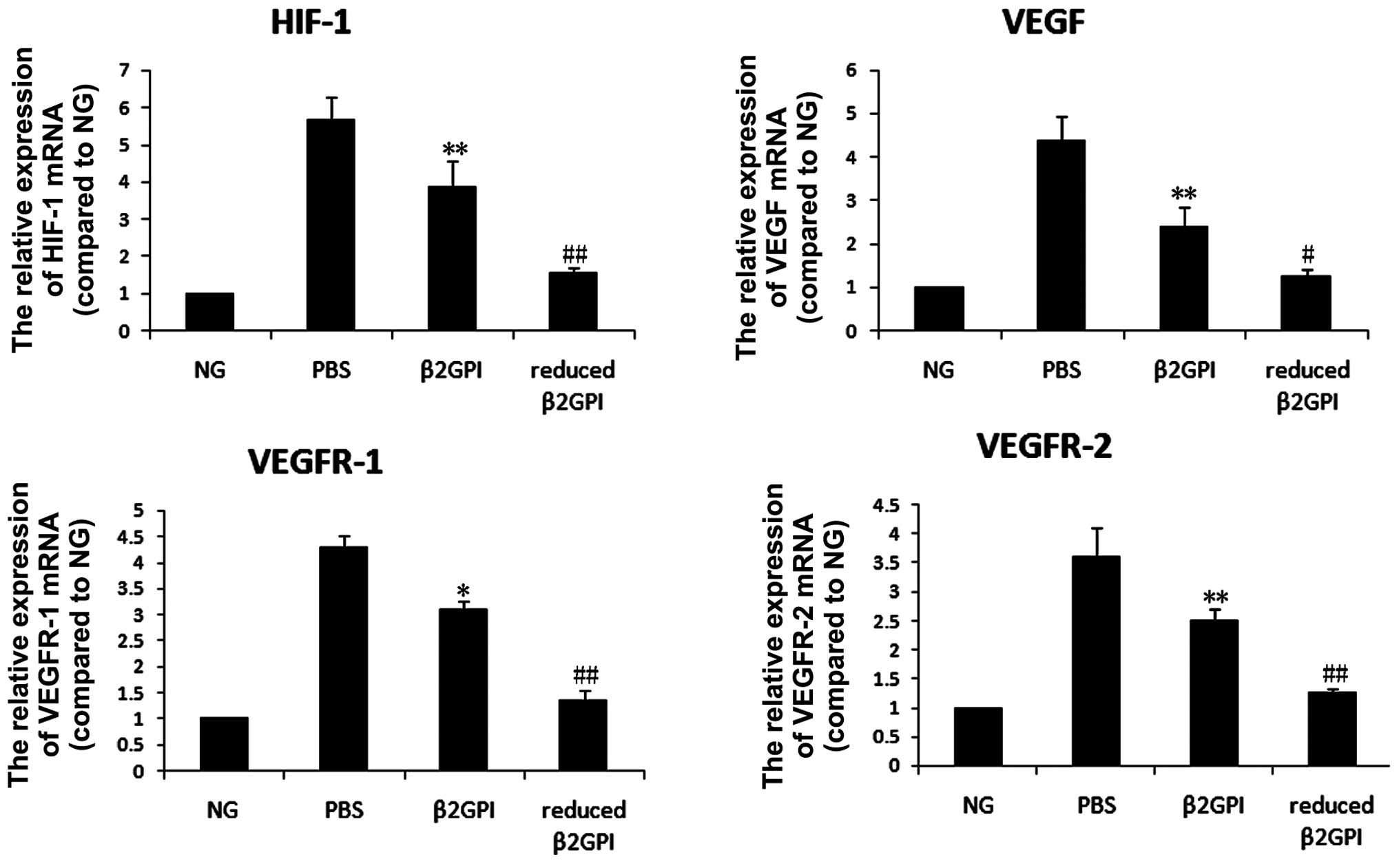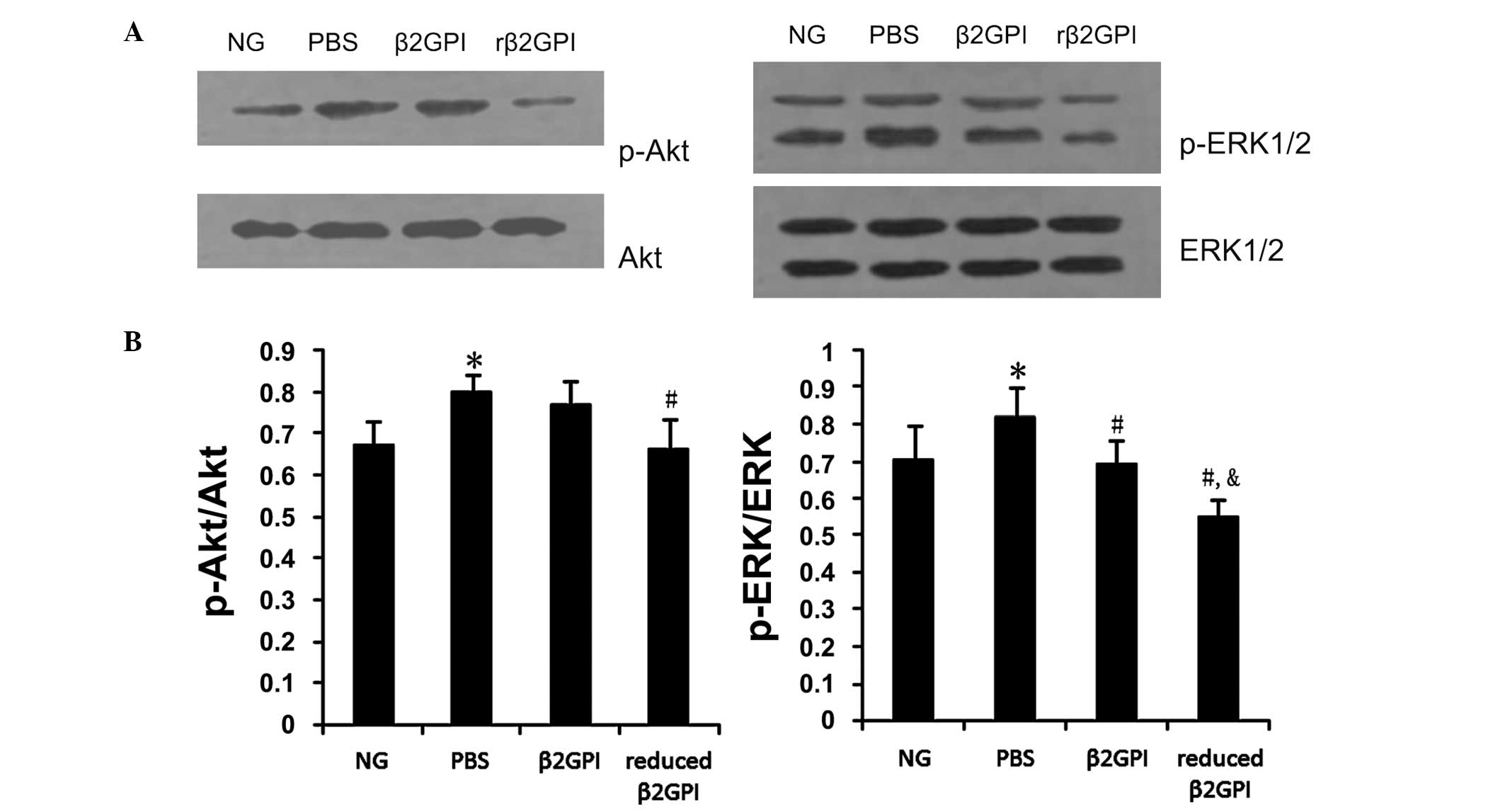Reduced β‑2‑glycoprotein І inhibits hypoxia‑induced retinal angiogenesis in neonatal mice through the vascular endothelial growth factor pathway
- Authors:
- Published online on: November 5, 2014 https://doi.org/10.3892/mmr.2014.2869
- Pages: 1025-1030
Abstract
Introduction
Neovascularization is an important characteristic pathology of diabetic retinopathy (DR), retinopathy of prematurity and other hypoxic-ischemic retinal diseases (1). The resulting ectopic network of blood vessels can cause hemorrhage in the retina, choroid and vitreous, leading to retinal detachment and irreversible blindness. These diseases are one of the main causes of acquired blindness worldwide (2), and reliable animal models are required to further understand the underlying molecular mechanisms in order to develop preventative strategies.
The oxygen-induced retinopathy (OIR) model for research into retinal neovascularization was first described by Smith et al (3) in 1994. In this murine model there are two phases in the OIR pathological process: A 75% oxygen phase (hyperoxia) and a 21% oxygen phase (relative hypoxia). Hyperoxia induces the cessation of normal vessel growth and the regression of existing vessels, accompanied by a decrease in vascular endothelial growth factor (VEGF) expression. Relative hypoxia then induces an overexpression of pro-angiogenic substances, including VEGF, that causes the retina to initiate pathological neovascularization (3). Due to the pivotal role of VEGF in this angiogenesis, VEGF may be a potential novel therapeutic target for retinal neovascular diseases.
β-2-glycoprotein I (β2GPI), also known as apolipoprotein H, downregulates VEGF signaling pathways and inhibits angiogenesis (4). Therefore, β2GPI represents a potential target in the treatment of DR. β2GPI is a phospholipid-binding plasma protein consisting of five homologous repeated units (domains I to V) (5). The cysteine (Cys) 288-Cys326 disulfide bond in domain V can be reduced by thiol oxidoreductase thioredoxin-1 or protein disulfide isomerase to form reduced β2GPI (6). Reduced β2GPI exhibits increased binding to von Willebrand factor through disulfide bonds and is able to protect endothelial cells, including EA.hy926 human endothelial cells, from oxidative stress-induced cell death in vitro (7,8). Reduced β2GPI may therefore attenuate neovascularization through the amelioration of oxidative stress or through direct effects on VEGF activity.
In the present study, a mouse model of OIR was used to investigate the effects of β2GPI and reduced β2GPI on retinal neovascularization and to delineate the underlying molecular mechanisms.
Materials and methods
Animals and reagents
C57BL/6J newborn mice and nursing female mice were obtained from the Experimental Animal Center of Peking University Health Science (Beijing, China). β2GPI and reduced β2GPI were prepared as previously described (6). Evans Blue, diethylpyrocarbonate, EDTA and hematoxylin and eosin (H&E) were purchased from Sigma-Aldrich (St Louis, MO, USA); RNasin Inhibitor and Moloney Murine Leukemia Virus (M-MLV) Reverse Transcriptase were purchased from Promega Corp. (Madison, WI, USA); SYBR® Premix Ex Taq™ DNA polymerase was purchased from Takara (Dalian, China) and TRIzol™ reagent was purchased from Invitrogen Life Technologies (Carlsbad, CA, USA). Rabbit anti-mouse polyclonal antibodies to Akt, phosphorylated- (p-) Akt, extracellular signal-regulated kinase 1/2 (ERK1/2), p-ERK1/2 and cluster of differentiation (CD) 34 were purchased from Bioworld Technology, Inc. (St. Louis Park, MN, USA). The quantitative polymerase chain reaction (qPCR) reaction primer sequences were designed by Primer 5.0 software (Premier Biosoft International, Palo Alto, CA, USA). and were synthesized by Beijing Genomics Institute (Beijing, China).
Animal model of proliferative retinopathy
All applicable institutional (Tianjin Medical University, Tianjin, China) and governmental regulations concerning the ethical use of animals were followed during this study. A reproducible model of OIR has been described previously in detail (3). Briefly, seven-day-old C57BL/6J mice, together with their nursing mothers, were exposed to 75±2% oxygen (hyperoxia) for five days before being returned to normal atmospheric conditions for a further five days. These mice were then randomly divided into three treatment groups and administered intravitreal injections of (respectively) 1 μl phosphate-buffered saline (PBS), 1 μl 800 μg/ml β2GPI or 1 μl 800 μg/ml reduced β2GPI. Mice of the same strain and age were kept in normal atmospheric conditions for use as a control group.
Histological quantification of retinal neovascularization and immunohistochemistry
Mice were sacrificed by cervical vertebra dislocation. The eyes were enucleated, fixed with 4% (w/v) paraformaldehyde in PBS and embedded in paraffin. Starting at the optic nerve head, a series of 6-μm, paraffin-embedded axial retinal sections were obtained, and these sections were stained with H&E. Sections were examined for evidence of neovascularization by an individual blinded to the treatment groups using light microscopy. Neovascularization was quantified by the number of retinal vascular endothelial cell nuclei anterior to the inner limiting membrane (ILM). Counts were performed in 10 transverse sections through the center of the eye to produce an average number of neovascular cell nuclei/section/eye.
The paraffin sections underwent dewaxing, rehydration, antigen retrieval and treatment with 4% hydrogen peroxidase. Normal goat serum was used as a protein block and the sections were then incubated with rabbit anti-mouse polyclonal anti-CD34 antibody overnight at 4°C. Following incubation with the primary antibody, the sections were incubated with biotinylated rabbit anti-mouse secondary antibody (diluted 1:200; Boster Biological Technology Co., Wuhan, China) for 20 min at 37°C and washed three times with PBS. Streptavidin-Horseradish Peroxidase Conjugate dilution buffer (Boster Biological Technology Co.) was subsequently applied for 20 min at 37°C prior to washing three times with PBS. The tissue sections were incubated in diaminobenzidine solution and counterstained with hematoxylin, prior to being dehydrated and mounted. PBS, in place of mouse monoclonal anti-CD34 antibody, was used as a negative control.
Angiography with Evans Blue
Mice were anesthetized by intraperitoneal injection of sodium pentobarbital (300 mg/kg) and were sacrificed by intracardiac perfusion with 1 ml normal saline containing 30 mg/ml Evans Blue. The eyes were subsequently enucleated and fixed in 4% (w/v) paraformaldehyde for 2–3 h at room temperature. The retinas were then dissected into four quadrants and flat-mounted onto microscope slides with neutral resin glue. Images, which were obtained by fluorescence microscopy, were analyzed using Adobe Photoshop (Adobe Systems Software Inc., San Jose, CA, USA) and the areas of non-perfusion and neovessels were calculated as a percentage of the total area of the retina.
Reverse transcription-qPCR
Enucleated eyes were used to prepare fresh retinas for RNA isolation. Total RNA was isolated using TRIzol™ reagent according to the manufacturer’s instructions (Invitrogen Life Technologies). Having tested for nucleic acid integrity, an aliquot of RNA extract (1.5 μg) was reverse-transcribed into cDNA using M-MLV Reverse Transcriptase. Primers were designed using Primer 5.0 software (Premier Biosoft, Palo Alto, CA, USA) and had the following sequences: VEGF forward, 5′-CTGGGCACTGCCTGGAAGAAT-3′ and reverse, 5′-GGAAGATGAGGAAGGGTAAGC-3′; VEGFR-1 forward, 5′-CAAGCCAACGTCCAACAGGAT-3′ and reverse, 5′-GCCCAGCAGAGTGCTAGTGTC-3′; VEGFR-2 forward, 5′-CAAGCCAACGTCCAACAGGAT-3′ and reverse, 5′-CCCTGAGTCAGCGTGAACTGC-3′; hypoxia-inducible factor-1 (HIF-1) forward, 5′-ATAAATGTTCTGCCCACCCTG-3′ and reverse, 5′-GACCCAACCACAAAGAGCAAG-3′; β-actin forward, 5′-TGGAGAAGAGCTATGAGCTGCCTG-3′ and reverse, 5′-GTGCCACCAGACAGCACTGTGTTG-3′. The PCR was perfomed using an iQ™5 Real-Time PCR Detection system (Bio-Rad Laboratories, Hercules, CA, USA). PCR cycling conditions were set as follows: 95°C for 5 min, 40 cycles at 95°C for 30 sec, then 56°C for 30 sec and 72°C for 30 sec. Melting curve analysis was subsequently performed between 55 and 95°C by monitoring fluorescence with 0.5°C increments at 30-sec intervals. All sample measurements were performed in triplicate. Estimates of the quantity of the PCR product were obtained by densitometry using the Quantity One® analysis software package (Bio-Rad Laboratories). For each experimental sample, target mRNA levels were normalized to β-actin mRNA levels.
Western blot analysis
Mouse retinas were collected and incubated in lysis buffer containing protease inhibitors (20 mM Tris, pH 7.4; 150 mM NaCl; 1 mM EDTA; 1 mM phenylmethylsulfonyl fluoride; 1 mM orthovanadate; 1 μg/ml leupeptin and 10 μg/ml aprotinin). Following homogenization and centrifugation, the amount of protein in the supernatant was determined with the bicinchoninic acid protein assay kit (Sigma-Aldrich). Aliquots of extract (35 μg protein per lane) from each sample were separated by SDS-PAGE using a 10% Tris-glycine gel prior to being transferred onto a polyvinylidene fluoride (PVDF) membrane at 65 V for 2 h. Following blocking of the nonspecific binding sites by incubation with 5% skimmed milk for 1 h, the membrane was incubated with rabbit anti-mouse polyclonal antibodies against Akt, p-Akt, ERK and p-ERK (1:1,000 dilution) overnight at 4°C. The membrane was subsequently incubated with horseradish peroxidase-conjugated secondary antibody (goat anti-rabbit) for 1 h at room temperature. Peroxidase activity on the PVDF membranes was visualized on X-ray film with an ultra-violet transmission analyzer (GE Healthcare, Piscataway, NJ, USA).
Statistical analysis
Data were analyzed using SPSS 18.0 (SPSS Inc., Chicago, IL, USA). The results are expressed as the mean ± standard error of the mean. One-way analysis of variance was used to evaluate statistically significant differences. P<0.05 was considered to indicate a statistically significant difference.
Results
Histological quantification of retinal neovascularization and immunohistochemistry
The histological quantification and immunohistochemistry results are shown in Fig. 1. The OIR protocol resulted in a >40-fold increase in the number of endothelial cell nuclei anterior to the ILM (controls, 0.67±0.816 vs. PBS, 32.5±7.342; P<0.05). Both β2GPI and reduced β2GPI significantly inhibited this increase (9.33±2.16 and 5.17±2.32, respectively; P<0.01), with the effect of the reduced β2GPI observed to be statistically significantly stronger (P<0.05) (Fig. 1A and C). Immunohistochemical staining demonstrated that the cells anterior to the ILM were vascular endothelial cells (Fig. 1B).
Effects of β2GPI and reduced β2GPI on neovessels in the OIR mouse model
The vessels in the normal control group were mature and showed a normal radial distribution from the optic disc, as well as exhibiting a thicker diameter and a clear peripheral retinal structure, with the vessels forming vascular arcades along the peripheral retina. However, in the OIR PBS group, the diameter of blood vessels was reduced, and there was evidence of retinal neovessel formation, vessel leakage and an enlargement of the non-perfusion region. When formally quantified, the differences between the PBS and control groups were found to be statistically significant (P<0.01). Treatment with β2GPI resulted in restoration of vessel thickness. Furthermore, the formation of retinal neovessels, the vessel leakage and the enlarged non-perfusion region were significantly reduced as compared with the PBS group (P<0.01). This abrogation was even more marked with reduced β2GPI treatment (Fig. 2).
Effects of β2GPI and reduced β2GPI on mRNA expression in retinopathy
The mRNA expression levels of VEGF, VEGFR-1, VEGFR-2 and HIF-1 were increased 2.5–4-fold by the induction of retinopathy (P<0.05 or P<0.01) in the PBS group compared with the levels in the untreated control group. β2GPI and reduced β2GPI both inhibited this increase (P<0.05 and P<0.01 respectively), with the effect of reduced β2GPI observed to be stronger than that of β2GPI (P<0.05 or P<0.01) (Fig. 3).
Effects of β2GPI and reduced β2GPI on the VEGF signaling pathway
Statistically significant increases in p-ERK1/2 and p-Akt levels were observed in the PBS-treated group (P<0.05), as compared with the untreated control group. β2GPI inhibited this increase in p-ERK1/2 in the retina (P<0.05); however, although the expression of p-Akt decreased following treatment with β2GPI, this did not attain statistical significance. The expression of p-Akt and p-ERK1/2 in the retina showed a statistically significant decrease upon treatment with reduced β2GPI (P<0.05) when compared with the expression in the PBS and β2GPI groups (Fig. 4).
Discussion
Proliferative DR (PDR) is one of the most severe microvascular complications in patients with diabetes and is the major cause of acquired blindness. One important pathogenic mechanism in PDR is neovascularization through inappropriate angiogenesis. Passam et al (9) showed that the plasma glycoprotein β2GPI has the potential to reduce angiogenesis; through the same mechanism, β2GPI reduces the growth of tumor implants in mouse models (10). In the present study, it was shown that β2GPI exerts a stronger effect than β2GPI in its inhibition of neovascularization. These effects were regulated through VEGF and its important downstream targets, the phosphatidylinositol 3-kinase (PI3K)/Akt and mitogen-activated protein kinase (MAPK)/ERK signaling pathways. Angiogenesis is a complicated physiological process in vivo. In addition to angiogenic factors, such as VEGF, fibroblast growth factor and angiopoietin (11–14), this process includes anti-angiogenic factors: Platelet factor-4, the expression of which can be increased by β2GPI (15), angiostatin, thrombospondin-1 and numerous others (16–19). Angiogenic and anti-angiogenic factors maintain a dynamic balance under physiological conditions. A disruption of this balance can result in various pathologies. When anti-angiogenic factors dominate, the blood vessels are in a stationary or degradative state; when angiogenic factors dominate, the blood vessel formation process is initiated.
In this study, it was shown that reduced β2GPI inhibited retinal angiogenesis. This was accompanied by the downregulation of VEGF, a key pro-angiogenic factor, and VEGFR-1/2. It remains unclear how reduced β2GPI downregulates VEGF and VEGFR; however, the data presented in this study showed that reduced β2GPI downregulates the expression of VEGF and VEGFR at the transcriptional level.
The PI3K/Akt signaling pathway influences angiogenesis and nutrient supply through the modulation of various factors, including endothelial nitric oxide synthase, HIF-1 and glycogen synthase kinase 3 (20,21), and promotes a survival response in endothelial cells, thus preventing apoptosis of these cells. This signaling pathway is also involved in preventing the degradation of newly-formed, immature lumen. Data from this study showed that reduced β2GPI significantly inhibited VEGF-induced Akt phosphorylation. ERK, a central protein of the MAPK/ERK signaling pathway (22), plays a key role in angiogenesis by entering the nucleus and activating nuclear factor κ-light-chain-enhancer of activated B cells (23,24), followed by the induction of DNA synthesis and cell proliferation. The findings in the present study showed that reduced β2GPI blocked the phosphorylation of ERK1/2, thus suggesting this mechanism to be causative for the negative effect of reduced β2GPI on retinal angiogenesis.
In conclusion, β2GPI and reduced β2GPI may have potential anti-angiogenic activity in vivo. Both significantly inhibited pathological retinal angiogenesis, with the effect of reduced β2GPI observed to be stronger. β2GPI and reduced β2GPI were shown to act by downregulating the expression of HIF-1, VEGF and its receptors, VEGFR-1/VEGFR-2, on endothelial cells, and blocking the phosphorylation of ERK1/2 and Akt, downstream targets of VEGF in the MAPK/ERK and PI3K/Akt pathways. Intravitreal injection of reduced β2GPI to inhibit neovascularization may therefore provide a novel approach to the treatment of PDR.
Acknowledgements
The authors would like to thank the National Natural Science Foundation of China (nos. 30971393 and 81070645), the Tianjin Natural Science Fund (nos. 10JCYBJC12000 and 13ZCZDSYO1300), the Tianjin Health Bureau Natural Science Fund (nos. 09KZ01, 09KZ89 and 12KG135) and the Tianjin Medical University Science and Technology Fund (no. 2009ky25).
References
|
Tolentino MJ: Current molecular understanding and future treatment strategies for pathologic ocular neovascularization. Curr Mol Med. 9:973–981. 2009. View Article : Google Scholar : PubMed/NCBI | |
|
Wang FH, Liang YB, Zhang F, et al: Prevalence of diabetic retinopathy in rural China: the Handan Eye Study. Ophthalmology. 116:461–467. 2009. View Article : Google Scholar : PubMed/NCBI | |
|
Smith LE, Wesolowski E, McLellan A, et al: Oxygen-induced retinopathy in the mouse. Invest Ophthalmol Vis Sci. 35:101–111. 1994.PubMed/NCBI | |
|
Yu P, Passam FH, Yu DM, Denyer G and Krilis SA: Beta2-glycoprotein I inhibits vascular endothelial growth factor and basic fibroblast growth factor induced angiogenesis through its amino terminal domain. J Thromb Haemost. 6:1215–1223. 2008. View Article : Google Scholar : PubMed/NCBI | |
|
de Laat B, van Berkel M, Urbanus RT, et al: Immune responses against domain I of β(2)-glycoprotein I are driven by conformational changes: domain I of β(2)-glycoprotein I harbors a cryptic immunogenic epitope. Arthritis Rheum. 63:3960–3968. 2011. View Article : Google Scholar : PubMed/NCBI | |
|
Passam FH, Rahgozar S, Qi M, et al: Beta 2 glycoprotein I is a substrate of thiol oxidoreductases. Blood. 116:1995–1997. 2010. View Article : Google Scholar : PubMed/NCBI | |
|
Passam FH, Rahgozar S, Qi M, et al: Redox control of β2-glycoprotein I-von Willebrand factor interaction by thioredoxin-1. J Thromb Haemost. 8:1754–1762. 2010. View Article : Google Scholar : PubMed/NCBI | |
|
Ioannou Y, Zhang JY, Passam FH, et al: Naturally occurring free thiols within beta 2-glycoprotein I in vivo: nitrosylation, redox modification by endothelial cells and regulation of oxidative stress induced cell injury. Blood. 116:1961–1970. 2010. View Article : Google Scholar : PubMed/NCBI | |
|
Passam FH, Qi JC, Tanaka K, Matthaei KI and Krilis SA: In vivo modulation of angiogenesis by beta 2 glycoprotein I. J Autoimmun. 35:232–240. 2010. View Article : Google Scholar : PubMed/NCBI | |
|
Beecken WD, Engl T, Ringel EM, et al: An endogenous inhibitor of angiogenesis derived from a transitional cell carcinoma: clipped beta2-glycoprotein-I. Ann Surg Onco. 13:1241–1251. 2006. View Article : Google Scholar | |
|
Yoncopoulos GD, Davis S, Gale NW, Rudge JS, Wiegand SJ and Holash J: Vascular-specific growth factors and blood vessel formation. Nature. 407:242–248. 2000. View Article : Google Scholar | |
|
Yoshida S, Yoshida A and Ishibashi T: Induction of IL-8, MCP-l, and bFGF by TNF-alpha in retinal glial cells: implications for retinal neovascularization during post-ischemic inflammation. Graefes Arch Clin Exp Ophthalmol. 242:409–413. 2004. View Article : Google Scholar : PubMed/NCBI | |
|
Feng Y, vom Hagen F, Pfister F, et al: Impaired pericyte recruitment and abnormal retinal angiogenesis as a result of angiopoietin-2 overexpression. Thromb Haemost. 97:99–108. 2007.PubMed/NCBI | |
|
Gardiner TA, Gibson DS, de Gooyer TE, de la Cruz VF, McDonald DM and Stitt AW: Inhibition of tumor necrosis factor-alpha improves physiological angiogenesis and reduces pathological neovascularization in ischemic retinopathy. Am J Pathol. 166:637–644. 2005. View Article : Google Scholar : PubMed/NCBI | |
|
Zhang R, Zhou SJ, Li CJ, et al: C-reactive protein/oxidised low-density lipoprotein/β2-glycoprotein I complex promotes atherosclerosis in diabetic BALB/c mice via p38mitogen-activated protein kinase signal pathway. Lipids Health Dis. 12:422013. View Article : Google Scholar | |
|
Ljubimov AV, Caballero S, Aoki AM, Pinna LA, Grant MB and Castellon R: Involvement of protein kinase CK2 in angiogenesis and retinal neovascularization. Invest Ophthalmol Vis Sci. 45:4583–4591. 2004. View Article : Google Scholar : PubMed/NCBI | |
|
Uusitalo-Jarvinen H, Kurokawa T, Mueller BM, Andrade-Gordon P, Friedlander M and Ruf W: Role of protease activated receptor l and 2 signaling in hypoxia-induced angiogenesis. Arterioscler Thromb Vasc Biol. 27:1456–1462. 2007. View Article : Google Scholar : PubMed/NCBI | |
|
Qiao H, Sonoda KH, Ikeda Y, et al: Interleukin-18 regulates pathological intraocular neovascularization. J Leukoc Biol. 81:1012–1021. 2007. View Article : Google Scholar : PubMed/NCBI | |
|
Wu Z, Wang S, Sorenson CM and Sheibani N: Attenuation of retinal vascular development and neovascularization in transgenic mice over-expressing thrombospondin-l in the lens. Dev Dyn. 235:1908–1920. 2006. View Article : Google Scholar : PubMed/NCBI | |
|
Tchaikovski V, Olieslagers S, Böhmer FD and Waltenberger J: Diabetes mellitus activates signal transduction pathways resulting in vascular endothelial growth factor resistance of human monocytes. Circulation. 120:150–159. 2009. View Article : Google Scholar : PubMed/NCBI | |
|
Park JH, Lee JY, Shin DH, Jang KS, Kim HJ and Kong G: Loss of Mel-18 induces tumor angiogenesis through enhancing the activity and expression of HIF-1α mediated by the PTEN/PI3K/Akt pathway. Oncogene. 30:4578–4589. 2011. View Article : Google Scholar : PubMed/NCBI | |
|
Modi H, Li L, Chu S, Rossi J, Yee JK and Bhatia R: Inhibition of Grb2 expression demonstrates an important role in BCR-ABL-mediated MAPK activation and transformation of primary human hematopoietic cells. Leukemia. 25:305–312. 2011. View Article : Google Scholar : | |
|
Parikh N, Shuck RL, Nguyen TA, Herron A and Donehower LA: Mouse tissues that undergo neoplastic progression after K-Ras activation are distinguished by nuclear translocation of phospho-Erk1/2 and robust tumor suppressor responses. Mol Cancer Res. 10:845–855. 2012. View Article : Google Scholar : PubMed/NCBI | |
|
Taylor SM, Nevis KR, Park HL, et al: Angiogenic factor signaling regulates centrosome duplication in endothelial cells of developing blood vessels. Blood. 116:3108–3117. 2010. View Article : Google Scholar : PubMed/NCBI |













